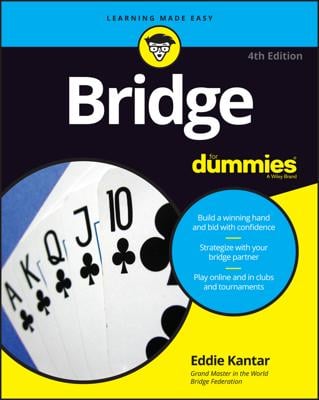-
When you have a sequence of three honor cards: Sequences of honor cards (three adjacent honors or the third card in the sequence missing by one place) make such strong leads that you must have a good reason not to lead one if you are lucky enough to have one. When you’re blessed with such a sequence, you lead the top (or highest) card from the sequence.
-
When you have two touching honor cards: Suits that have two touching honors, such as the AK632, KQ6, QJ82, or J1053, also warrant leading the top card.
-
When you have a short suit: Leading a short suit (a singleton [one card] or a doubleton [two cards]) against a trump contract is a very tempting lead — few can resist it. If your lead works out, you can trump one or two of the declarer’s tricks before the declarer can draw trumps. But don’t rush to judgment every time you have a short suit lead available. You may not want to trump anything — your trump holding may be too strong, like in this image.

-
When your partner bids a suit: You tend to lead that suit. One of the reasons your partner bids a suit is to help you out on the opening lead. Unless you can find a strong alternative lead, look no further than your partner’s suit.
-
When one suit hasn’t been bid: When the opponents bid three suits, consider leading the unbid suit. As a general rule, you tend to look for the opening lead in places where the opponents have not advertised strength, and the unbid suit is a likely candidate.
-
When two suits haven’t been bid: When you need to choose between two unbid suits, lead from the stronger suit. However, if one of the suits is headed by an unsupported ace (an ace without the king), lead the other suit.
-
When you have four trumps: Run the declarer out of trumps by making him trump the suit you are leading. A good bet is to lead the fourth highest card from your long suit unless the suit is headed by a sequence, then lead the top card.
-
When you want to remove the dummy’s trumps by leading a trump: Sometimes leading a trump card can be a primo idea. For example, if the declarer bids two suits and you’re very strong in one of those suits, but the opponents wind up in the other suit, you usually lead a low trump.
-
When you have the ace of a suit: You may come across instances when you may need to bang down an ace on the opening lead, such as if your partner has bid the suit, the opponents have bid every other suit, or you have a single or doubleton ace.
-
When you have a suit with no honor cards: Welcome to the pits. It doesn’t get much worse than having to lead from an empty suit with no honors in it. You have three or four cards, but for some reason, every other suit is taboo. The right lead from this holding is the top card (called the top of nothing), but you don’t have to like it.

